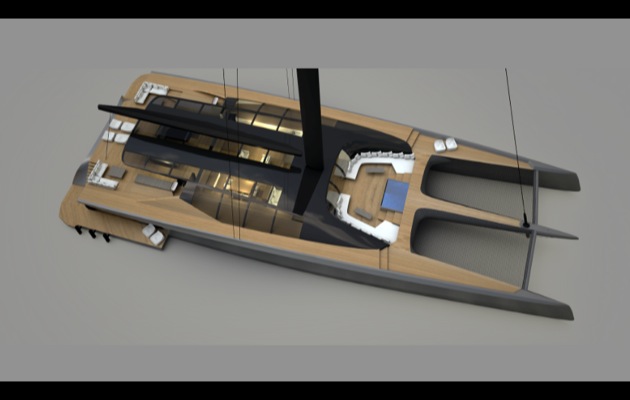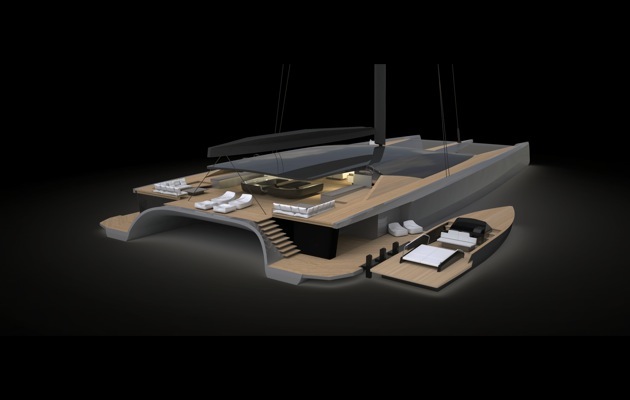Australian Olympic champion and multihull expert Mitch Booth has founded a new brand of luxury cruising superyacht catamarans called BlackCat. The first model is a 50m/165ft long and designed by Malcolm McKeon Yacht Design. If built, it will be the largest single structure carbon fibre yacht ever.
Every now and again you see a radical new concept that makes you grin in the knowledge that yacht design has just taken one brave step forward. This new BlackCat does just that – a design that is simply awesome.
“This ‘supercat’ concept is really exciting because there is nothing else available that combines the practicality of an enormous, stable, platform, with exhilarating performance,” said Booth.
And the BlackCat’s top speeds should be fiendish – estimated at between 25 to 30 knots for this first 50m showcase concept – setting a whole new benchmark for superyacht performance.
She remains very much a luxury cruiser however Booth insists. “By no stretch of the imagination is it to be like a semi-racer – there’ll be no pushing a bow under or flying a hull.”

The BlackCat is designed to be simple to manage and sail at speed, and palatial to liveaboard. Booth told us that he has been talking to McKeon about this concept for a couple of years, and that the Lymington based designer started to work on this concept last November.
What makes the BlackCat so refreshingly different is how sleek her lines have been kept. Supersize cats tend to grow vertically too, with high topsides to house accommodation and awkward flybridges.

Not so with the BlackCat. It’s almost as if she’s been created as an adrenaline-injecting poster for teenagers, one to hang next to Ferraris and fighter planes.
McKeon has even given her concave scoops in the topsides – like a classic Corvette – which he says is an aesthetic tool to break up the topsides. As BlackCat’s founder Mitch Booth has spent most of his life racing extreme multihulls, the BlackCat’s fuel-injected look should not surprise.
Booth says their target for the BlackCat range is between 100ft to 200ft long, where the latter represents the upper end of engineering capabilities today. “Width is a big factor – it adds stability and righting moment but also increases loads dramatically,” said Booth.
With all that beam, load, and speed potential, safety will be a primary concern. Booth insists that her performance will be perfectly manageable and that “no superyacht multihull should ever go close to flying a hull.”
As a floating platform this phenomenally beamy design presents serious dance floor potential. While the freeboard of McKeon’s sexy hull shape has been kept low and lean, accommodation space is still a phenomenal 340m2. The 20m beam of the 50m BlackCat for example helps create a surface area equivalent to half a football pitch.
“It’s a logical progression for superyacht designs to move towards catamarans,” said Booth. “There are so many advantages to large multihull cruising compared to our monohull cousins, such as speed, space, low heel, comfort, the list goes on and on.”

The hand of McKeon can be seen both in the lines and the extensive amount of glass used in the superstructure. There are also some ingenious solutions around the sunken bridgedeck, and the fold down aft quarters that reveal a tender garage and gym.
“There’s been a space in the market for some time for a large catamaran design that can offer the luxury and quality of a superyacht this size,” said McKeon, “and also provide this level of stability and high performance.”
Whilst the BlackCat might be able to get into shallower anchorages than most monohull superyachts, her swinging circle will be somewhat antisocial. And a BlackCat owner would need to get used to anchoring as stern-to marina docks might be limited.
Just the thought of owning a small island capable of shifting at 30 knots – is enough to make you giggle childishly.




